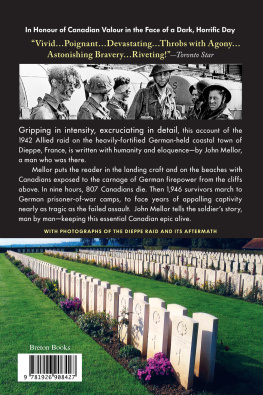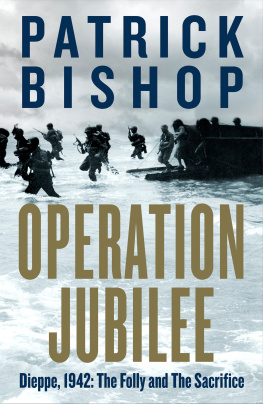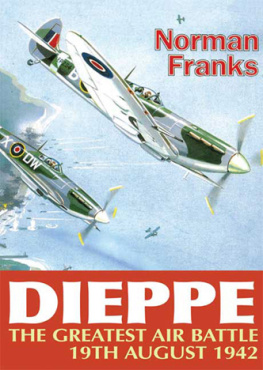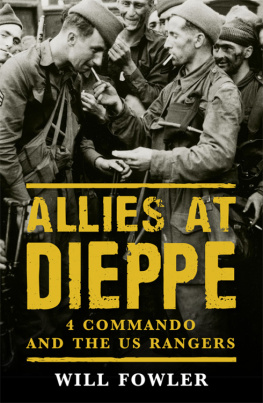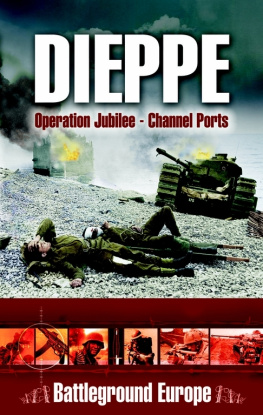Dieppe
Canadas Forgotten Heroes
An excellent and accurate account of the raid...a magnificent book on Dieppe.
Major General Churchill Mann, Deputy Military Force Commander during the Dieppe Raid
Mellor has skillfully stitched the blood-drenched story of the Dieppe raid into a devastating yet riveting narrative. Just as every square foot of the Dieppe beaches sang and roared with flying metal, every paragraph throbs with agony. Toronto Star

Unforgettable for all Canadians. Ottawa Journal
Excellent book.... John Mellor has brought the Dieppe disaster to life.... The definitive work on a defeat Canadians should celebrate rather than forget. Books in Canada
I congratulate you on Forgotten Heroes. You did a magnificent job.
Lt. Col. Robert R. Labatt,Commanding Officer, Royal Hamilton Light Infantry in the Dieppe Raid
DIEPPE
CANADAS FORGOTTEN HEROES
John Mellor
Breton Books
Copyright 2016 The Estate of John Mellor
Editor: Ronald Caplan
Production Assistants: Bonnie Thompson, Sharon Hope Irwin
eBook Design: Joseph Muise
Front Cover Photograph: Charly Triballeau/AFP/Getty Images, taken at the Dieppe Memorial in France, August 19, 201270 years after the Dieppe Raid. Front row, left to right: Dieppe veterans Fred Engelbrecht, 92, of Hamilton, Arthur Rossell, 92, of Brampton, and Roman Wozniak, 93, of Vancouver. Behind them, just left of centre, is Dieppe veteran Paul McGrath, the last surviving commando of the Intelligence Assault Unit.
In 2012, in the video Dieppe Uncovered, Paul McGrath said, We werent informed of that, when he learned for the first time from historian David OKeefe ( One Day in August ) that newly released secret files prove that the Dieppe Raid was an extremely vital mission that could have changed the course of the war and have saved millions of lives. Unknown to all the soldiers that hit the beach on August 19, 1942, the raid was intended to hide a daring attempt to capture an Enigma machine and secret German codesa pinch that, had it been successful, would have saved Allied shipping from the ravages of German submarines. Receiving that same news, McGraths comrade Ron Beal of the Royal Regiment of Canada told OKeefe, Despite the fact that it was never accomplishedthat doesnt mean anything. There was an objective. And I know in my heart that my comrades did not die for nothing.
Back Cover Photograph: The Canadian Dieppe War Cemetery in Hautot-Sur-Mer, France labattblueboy. Photo credits continue at end of book.
We acknowledge the support of the Canada Council for the Arts for our publishing program.
We recognize the support of the Province of Nova Scotia.We are pleased to work in partnership with the Province of Nova Scotia to develop and promote our creative industries for the benefit of all Nova Scotians.
Funded by the Government of Canada.
Library and Archives Canada Cataloguing in Publication
Mellor, John, 1922-2007 author
Dieppe : Canadas forgotten heroes / John Mellor.
Originally published under title Forgotten heroes, the Canadians at Dieppe:
Toronto: Methuen, 1975. Issued in print and electronic formats.
ISBN 978-1-926908-42-7 (paperback).
ISBN 978-1-926908-46-5 (ebook)
1. Dieppe Raid, 1942. 2. Canada. Canadian Army--History--World War, 1939-1945. 3. World War, 1939-1945--Canada. I. Title.
D756.5.D5M45 2016 940.5421425 C2016-903197-7 C2016-903198-5
Contents
CHAPTER ONE
A Rude Awakening
At 3:50 a.m., August 19, 1942, the citizens of the French port of Dieppe were roused by the sound of heavy gunfire out at sea.
Louis Larcheveque, who lived near the waterfront, switched on his bedside lamp. Should he seek shelter in the Passive Defence air-raid shelter nearby? Many times since the Germans had occupied his native land, M. Larcheveque had listened to similar outbursts, as Hunter groups of British Motor Torpedo Boats battled German E-boats in the English Channel. Hastily donning a dressing gown, he switched off the bedside light. Then he drew the heavy blackout curtains aside.
On the horizon to the east of the town, he saw high explosive shells bursting on the surface of the sea some distance away. Curving trajectories of multi-coloured tracer bullets added their own dazzling display as the battle raged back and forth, punctuated by the heavy rumble and crump of the shells. A few minutes later, the firing died down, then ceased. All that could be seen now was the flickering red and orange glow from burning hulks drifting aimlessly at the mercy of wind and tide before sinking from sight beneath the waves. Each ship died with a hiss of escaping steam as the cold waters snuffed the flames. For a few brief moments debris and ashes marked each site, then they too were gone with the strong Channel current. With sadness in his heart, M. Larcheveque returned to his bed to pray for the souls of those lost in battle.
The German troops garrisoned in the Dieppe area had also been alerted by the distant gunfire, but when the action ceased, they were ordered to stand down and return to their interrupted sleep.
Ten miles off the coast of Dieppe lay a German submarine chaser commanded by Lt. Bgel. Bgel vainly tried to warn the port authorities that he had intercepted a large number of Allied assault craft en route to Dieppe. Fortunately for the invading forces, a British shell had silenced the German ships radio transmitter. The German Naval Headquarters at Dieppe had already informed the army authorities that the brief gun battle at sea was nothing more than a routine attack by the British on a German convoy.
The moon had set just after 2 a.m. At 2:30 a.m., an hour and twenty minutes prior to the sea battle, the German shore radar detector installation had reported the presence of a number of ships some twenty-one miles from the port of Dieppe. It could have spelled disaster for the forthcoming invasion. But it was dismissed as a normal sighting of a German convoy, which had sailed from the port of Boulogne and was expected to arrive at Dieppe at 5 a.m.
The Allied assault craft crept nearer to the beaches of Dieppe. The element of surprise, which had been of paramount importance to the success of the operation, had been diminished. But while the huge enemy coastal guns remained silent, success was still possible.
At 4:50 a.m. Dieppe was again disturbed from its sleep. The sounds of firing seemed to be much closer to Dieppe and from the east and west of the town. M. Larcheveque hastily dressed his brood of small children before hustling them into the air-raid shelter. At 5 a.m., while excitedly discussing the latest development with his friend, M. Milet, the caretaker of the town hall, he saw a group of German soldiers enter the courtyard of the town hall and make their way to an anti-tank gun post overlooking the main beach.
High on the West Headland behind the mediaeval castle that dominates the main beach of Dieppe, M. Raymond le Roy and his wife had also been awakened by the sounds of battle. Their house lay only a few kilometres from the beaches at Pourville, a little village on the western outskirts of the town of Dieppe. First came sounds of rifle and mortar fire, then voices, shouting in English. The invading assault troops clattered through the village streets in their steel-shod boots. M. le Roy was thrilled. The Tommies had arrived at last! Liberation was at hand!
After settling Madame le Roy in the air-raid shelter, he gazed out to sea. Gun flashes from British destroyers bombarded the German shore defences. Overhead the bombers and fighters of the Royal Air Force suddenly swooped at rooftop level to strafe and bomb the enemy gun positions. On all sides he heard the sounds of breaking glass, falling masonry, the high-pitched scream of the mortally wounded. Surely an attack would soon be mounted against the main beaches of Dieppe.

